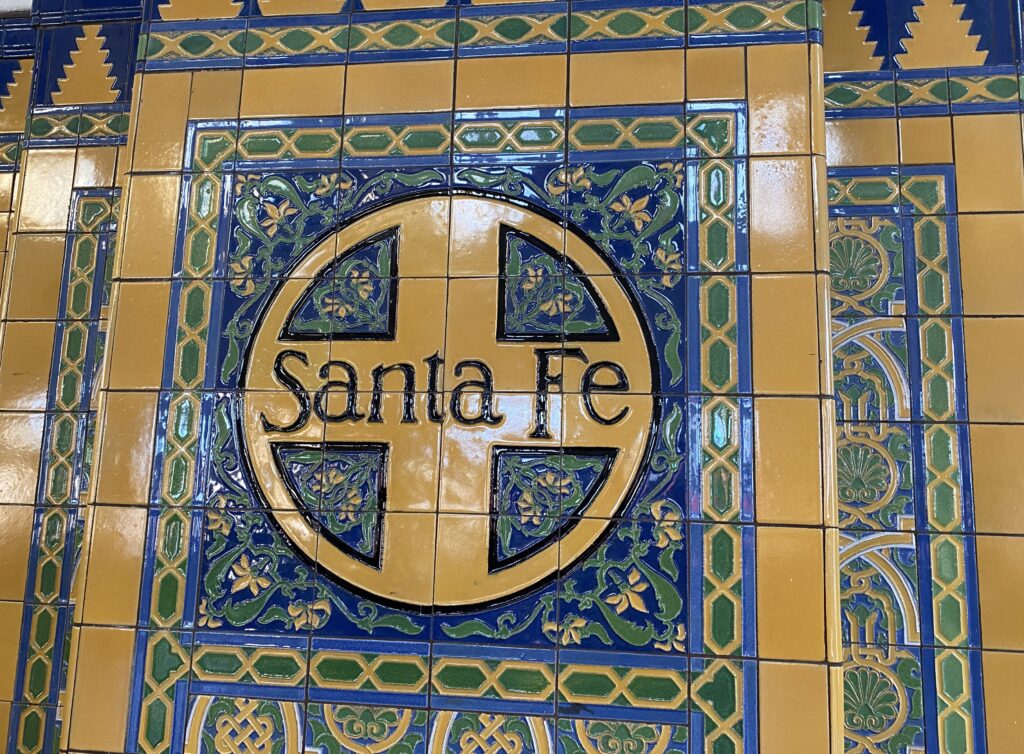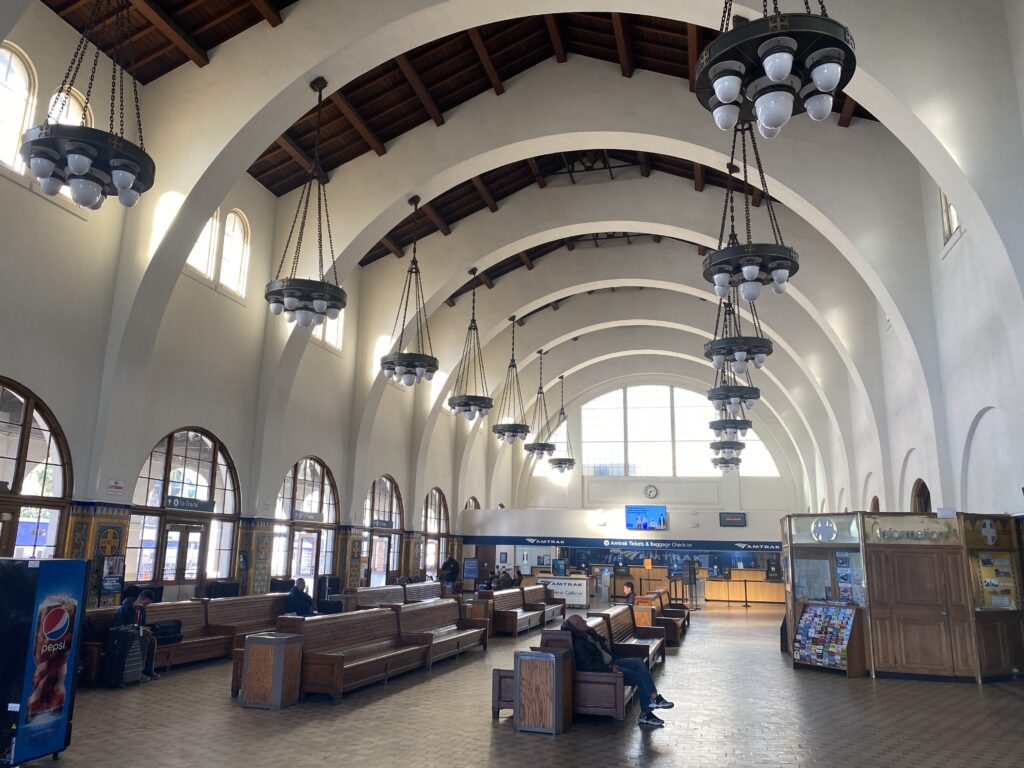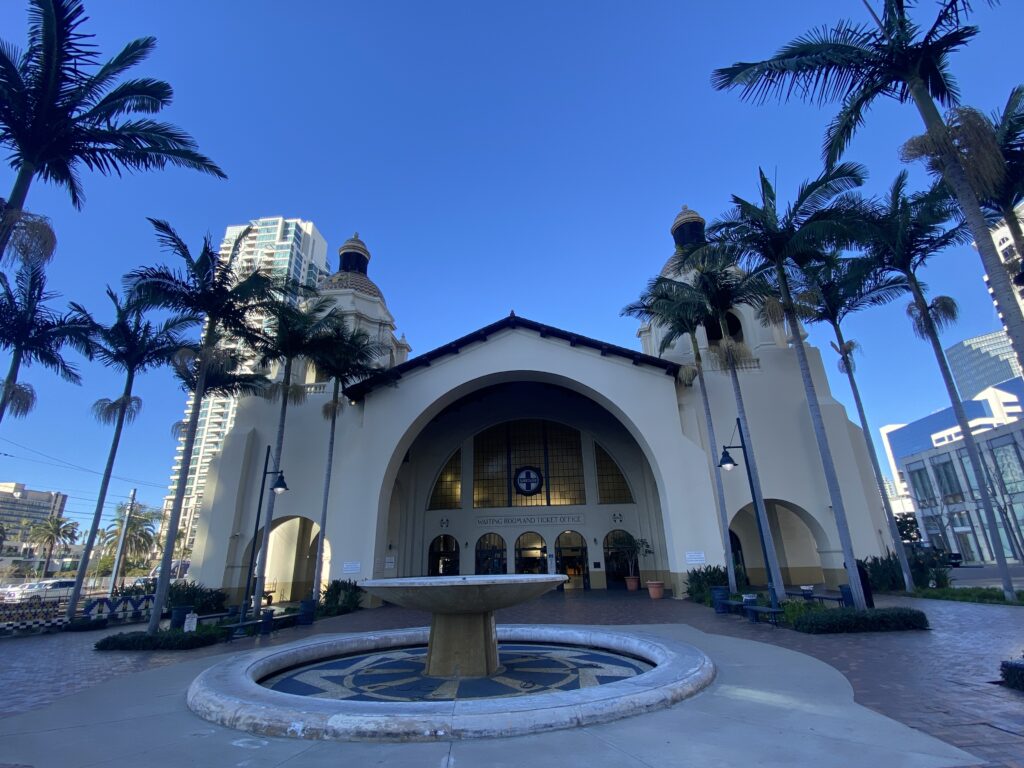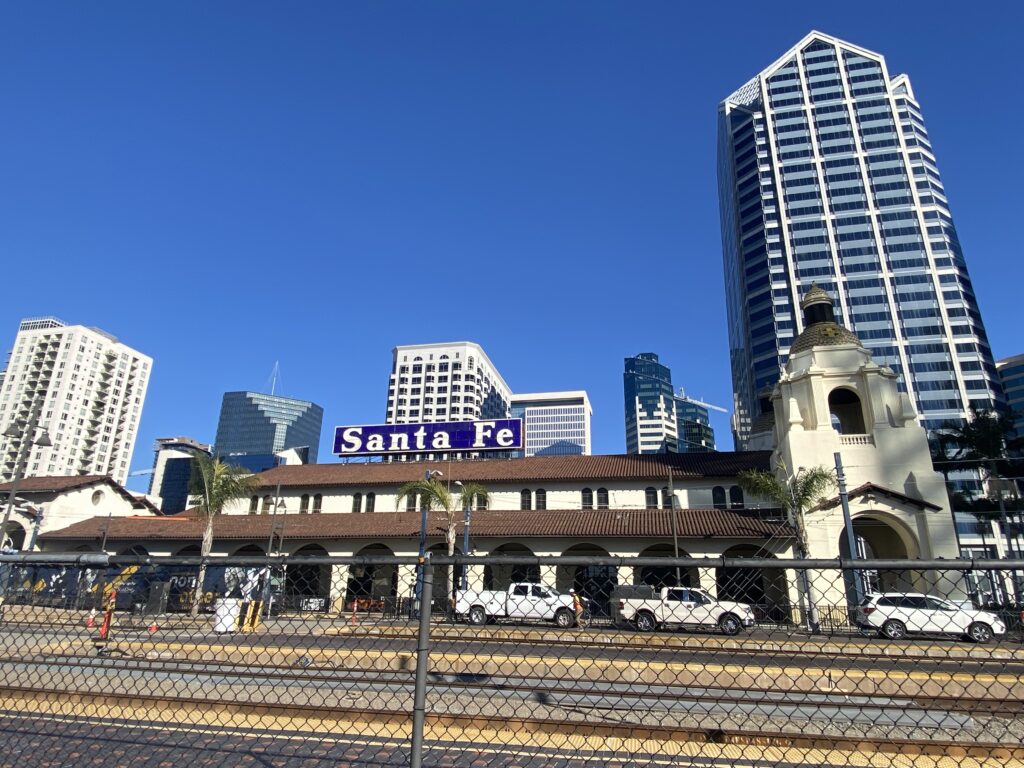No products in the cart.
Landmarks
The Romanticism of the Rails
Santa Fe Depot
(1915)
Architectural Style: Spanish/Mission Revival
Architects:John R. Bakewell and Arthur Brown Jr.
Not only have trains provided transportation and dramatically changed life in America, they also allowed faster, safer travel all over the country. They additionally facilitated the sending of goods and mail nationally.
Trains have been whisking travelers to far-flung destinations in style, comfort and relative speed for hundreds of years. There is something to be said for the slow, undulating rhythm and the hypnotizing sound of the rails, which lull you into an almost somnambulistic state, as it allows you to watch the fascinating and diverse beauty of the changing scenery. Who can forget the cross-country honeymoon trip of Elizabeth Taylor and Rock Hudson in “Giant,” or the fateful meeting of Tony Curtis and Marilyn Monroe in “Some Like It Hot?” Train travel has many benefits! Nobody knew this better than wealthy Victorians and Edwardians, who traveled in their own private cars, which were so sumptuous that they were essentially “luxury hotels on wheels.”
The advent of the Panama-California Exposition in San Diego, slated to begin on January 1, 1915 would bring thousands of international travelers to this fair city. Thus, the City Fathers came to the conclusion that the original Victorian frame train station, built in 1887, needed a serious expansion and upgrade. Although quaint and pleasant to look at, it would not suffice for the multitudes that were expected. As San Diego was the first major harbor on the West Coast, the opening of the Panama Canal and the resulting exposition seemed to cement San Diego as a major international destination.
Special fare packages were offered by the Atchison, Topeka and the Santa Fe Railroad, and they committed to building a new and larger train station to accommodate the expected crowds. They had initially built the Victorian, dark red and dark green structure with its numerous gables and prominent clock tower already receiving travelers to the city. The ATSF had additionally purchased the California Southern Railroad, the Los Angeles and San Gabriel Valley Railroad and the California Central Railroad, and had become one of the country’s largest and most profitable railroads.
The new Santa Fe Depot was designed by the San Francisco firm of Bakewell and Brown. They were experts in Arts and Crafts aesthetics and neoclassical architecture and space planning. The firm was also the designers of the San Francisco Civic Center, considered to be one of the country’s finest Beaux-Arts complexes. Beaux-Arts architecture featured the incorporation of French neoclassicism, Renaissance and Baroque elements using modern materials such as iron and glass. The $300,000, steel framed Santa Fe Depot was designed to incorporate Spanish Baroque elements without an excess of sculptural work. It instead included a Spanish tiled roof, decorative tile work, arcades and whitewashed walls. The facade of the depot was dominated by two identical domed towers covered in tiles in shades of blue, green, yellow and white. The towers were similar in design to those of the Expo buildings. The area between the towers featured an enormous arch, which gave way to five smaller arched doorways leading to the main waiting room. Large Diocletian windows ( semi-circular windows) at either end of the room allowed ample light to flood the interior.
The interior, which measured 170 feet by 55 feet, was capped by gabled ceilings of redwood, which supported large bronze chandeliers. Along the sides of the room were kiosks selling convenience items ( just like today!). The doors leading to the boarding platform were also arcaded to protect passengers from the strong California sun!
The most recognizable feature of the waiting room is the eight and a half foot tall wainscot (lower portion of the wall) composed of glazed tile manufactured by the California China Products Company of nearby National City. The elaborate Spanish tile designs and the finishing at the top and bottom edges are green, yellow, blue, white and black, finished with a frieze of ziggurats ( raised, pyramid shaped bases). The original oak benches still run the length of the room.

Beyond the waiting room was a Fred Harvey Dining Hall, also adorned with the same colorful tile work. The Harvey Company ran all the concessions for the ATSF. Upstairs on the east side of the second floor were offices. As the ATSF was very proud of the new structure, they plastered their logo on the building wherever possible. It can be found in the tile work of the domes and the waiting room pilasters, as well as on the chandeliers, windows and the roof. Beyond the waiting room was a one- story freight building and work space. The depot opened on March 8, 1915, three months after the opening of the Exposition. However, the exposition was such a success that it was extended for another year. Thus, this magnificent new structure definitely served its purpose.

Railroad travel started to decline in mid-20th century, and by 1971 the ATSF considered demolishing the structure. Strong community opposition stopped this notion in its tracks, and it was placed on the National Register of Historic Places in 1972.
Ten years later, the building was restored and refurbished, and has since gotten additional restoration. ADA compliant accommodations have been made, and a landscaped plaza complete with palms, a fountain and seating was installed. The adjoining Baggage and Express building was seismically retrofitted and restored to its 1914 appearance, and became a branch of the Museum of Contemporary Art.

The Santa Fe Depot has served residents and visitors to San Diego for more than a century, and is the third busiest in California, only behind Los Angeles and Sacramento. It also includes a variety of busses, a modern light rail streetcar (trolley) and a commuter rail service (Coaster). It is the southern terminus for Amtrak’s Pacific Surfliner, which runs from San Diego through Los Angeles and to San Luis Obispo, making it the second busiest rail corridor in the United States. All aboard!
Sandee is the Historian/Lead Tour Guide for the Gaslamp Quarter Historical Foundation. She can be reached at [email protected].

